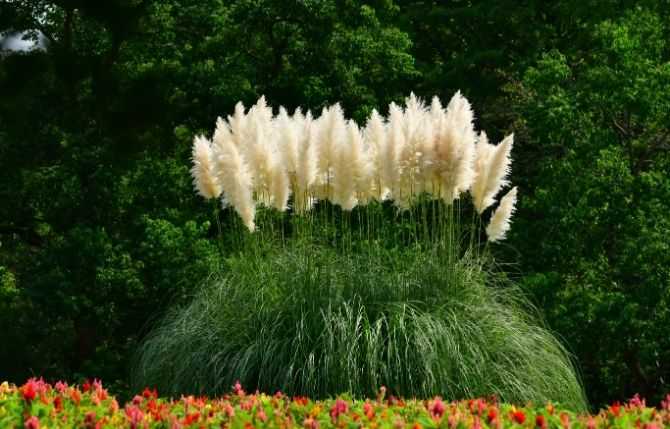If you are like most people, you have probably seen the large clumps of the lush foliage of pampas grass. It also comes with attractive feathery plumes, which are usually creamy white. Pampas grass (Cortaderia selloana) is a large ornamental grass that grows in many places across the world. It is a perennial flowering plant and can be used in a range of landscapes. As you might expect, when planting and taking care of any type of grass, pampas grass does not require a lot of time or effort. The purpose of this guide is to give you more information about cultivating and caring for pampas grass as well as other relevant uses tips and facts.
What Is Pampas Grass?
Cortaderia selloana, is native to South America, but it is now found in many countries, including the USA. The name comes from the Pampas region, a fertile South America region, including parts of Brazil, Uruguay, and Argentina. It has a range of uses, with the primary one being that it makes a great ornamental flower.
Pampas grass belongs to the Poaceae family, which includes other grasses such as cereal crops and bamboos. Pampas grass appears as a large grass and can grow well in sunny areas. There are many pampas grass cultivars, and these are available from nurseries.
Common pampas grass is hardy in the Coastal Plain (Zone 8). It is also marginally hardy in the Piedmont region, which encompasses Zone 6 and Zone 7. The cold-hardy cultivars of pampas grass are more appropriate for planting and growing in upper Piedmont. This includes the mountainous areas of north Georgia. As a general rule, pampas grass is hardy in USDA Zones 7-11. You can grow pampas grass in Zone 6 if it is in well-protected areas.
Colored Varieties
Most pampas grass produces white plumes, but you can also find it in other colors. Beautiful pink plumes are another popular variation. The pink feather pampas grass variety is an attractive addition to any garden.
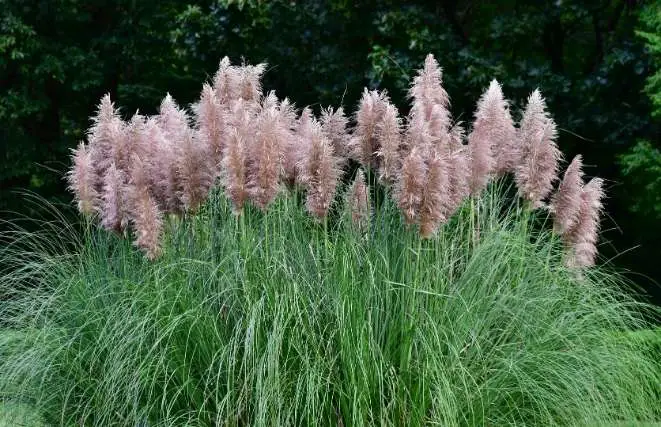
Parts of the Pampas Grass Plant
A pampas grass plant can grow as high as 10-13 feet, but the rarer dwarf varieties only grow to up to 5 feet. They also spread out about 6 feet wide, which is quite a large area for a grass plant. The long leaves of the grass are sharp-edged, and the stems are rigid.
A pampas grass plant has beautiful, fluffy plumes. These appear in their different colors in late summer. White is the most common color, but there are other shades and varieties.
Pampas grass has long and deep roots, and these make it hard to eliminate the plant. If the grass foliage and clumps are cut or burnt down, you might see them regrow in a matter of weeks.
The other important features of these types of grass depend on what sex they are. Each pampas grass can either be male or female. To find more information on this and the method of propagation and spreading, you can look at the propagation section of this pampas grass guide.
Uses of Pampas Grass
The primary use of pampas grass is as an ornamental or decorative plant. Its large plum-like flowers make it an attractive plant to add to any landscape. It grows as a large, bushy plant, so there must be enough space to accommodate the plant’s foliage’s height and breadth.
It’s not uncommon to find this large grass as the central attraction on a piece of lawn. They are great for gardens and around pool areas. Pampas grass clumps produce a lot of foliage, making the plant useful as a privacy screen or to limit views. You can also plant pampas grass to act as a protective hedge, given that the leaves are also sharp and rigid. The shrub also functions as a windbreak. All of this information can affect the ideal areas for planting pampas grass in your garden.
Dried pampas grass plumes are widely used in flower arrangements and other decorative purposes. These shrubs dry well and retain their structure and fluffiness, making them a popular decorative item to many homes.
Challenges of Pampas Grass
Despite its beauty, pampas grass does come with a few challenges. It is a very fast-growing grass and has the ability to take over a landscape and crowd out the existing shrubs. In many instances, this can damage natural habitats and hamper natural biodiversity.
Another issue with pampas grass is that the leaves are sharp and blade-like. They can be harmful to birds feeding or perching in the foliage.
Another thing to know about pampas grass is that it is flammable. Like most other types of grass, pampas grass dries up in the winter-time, and these dry leaves produce ready fodder for a fire. This means that you should avoid growing this grass if you like in areas where wildfires are common.
If you have pets, and dogs, in particular, you need to be careful when planting or keeping this type of vegetation. Dogs can have different reactions from consuming these grasses, including vomiting, diarrhea, and even depression.
Banning of Pampas Grass
Due to pampas grass’s ability to take over an area and upset the ecological balance, to an extent, it is banned in several places. For example, it is illegal to sell or propagate pampas grass in South Africa, where it is classified as a weed or invasive alien plant. Pampas grass is also banned in several other places, such as the state of Hawaii and parts of Australia and New Zealand. In the states of Texas and California, pampas grass is classified as an invasive weed. Pampas grass is on the USDA list of invasive plants to watch.
Suppose you are considering planting and looking after pampas grass for yourself. In that case, it is a good idea to find more information about the legalities of selling or cultivating this tough, invasive grass.
Controlling Pampas Grass
Pampas grass can be harmful and very invasive, but it is still widely used for ornamental purposes. It is possible to control the grass and restrict it from taking over a landscape. A few different methods are used to minimize it’s spreading and maintain the desired vegetation biodiversity of the areas.
Insecticides and herbicides are commonly used to limit pampas grass growth. In this method, the grass is cut near the base of the clumps, and insecticide is applied to stop the grass from growing again from the clumps. The best season to apply this method in the fall, where control is much easier.
Another method of preventing the seed dispersal and spreading of pampas grass is collecting, bagging, and disposing of the pampas grass inflorescence.
If the pampas grass is being grown for a person, you can also limit its spread by ensuring that the soil around it is not bare and susceptible to an invasion of the seeds and seedlings. There are two ways to do this: covering the soil with mulch or ensuring it is covered with other vegetation.
For places where growing pampas grass is not prohibited, it can be grown under controlled conditions to prevent it from overtaking all the other vegetation in the space. You can also consider planting sterile varieties of pampas grass, which are usually not as large and produce less foliage, making them good to keep things under control. These do not produce seed and can therefore not spread and overtake the area.
How to Grow Pampas Grass
If you live in a place where there are no restrictions on the sale and cultivation of pampas grass, you may be considering growing it. You can change up the landscape of your property with this beautiful and characteristic plume grass. You can get all the information you need to grow pampas grass right here.
Like many types of wild grass, you are going to find that pampas grass is extremely easy to grow and very fast-growing. You can find more information about how the shrub propagates, what the ideal weather conditions are, what kind of soil it grows in, as well as how to care for the clumps and foliage well and get the best results.
Before you set out to grow pampas grass, you should decide on an area of your garden that can handle the large clumps and lush foliage of this species. You should be comfortable with the grass’s expected height and breadth because it can be quite dominating. If there are some smaller flowers and bushes that require full sun nearby, then added some towering pampas grass next to them might not be the best idea.
Propagation of Pampas Grass
As previously mentioned, pampas grass plants propagate very fast. A single pampas grass plant can produce millions of seeds throughout the course of its useful life.
Dwarf varieties of pampas grass may be sterile. This means that they do not produce seeds and cannot spread.
Like other types of grass, pampas grass grows separate males and female varieties. With the female plants, the plumes are full and board. The female plants have silky hairs whose function is to cover up the tiny flowers of the grass. Female plants have plumes that are much showier than you see on the male ones. Additionally, the pampas grass’s male varieties do not have silky hair on their flowers like the female ones.
Vegetative propagation is a common method for propagating pampas grass. To do this, you can divide the clumps. You simply have to split the clumps from the female plants with a shovel and carry them to the space where you want to grow pampas grass. In most cases, you only have to divide the female clumps and not the male ones.
If you choose to grow pampas grass and propagate it from seed, you are likely to get the less attractive male version. You are also going to see a lot more generic variation using this method. Another challenge with propagating pampas grass from seed is that you can only see whether you have male or female plants when you have waited for the clumps to grow and produce flowers. While there is no other way to distinguish between the male and female plants before then, you should know that most cultivated clumps are female. The main reason for this is that the feathery flowers they produce are large and more attractive for decorative purposes.
Ideal Weather Conditions
Pampas grass grows in the warm weather of the summer. By the end of summer, you can expect to see the beautiful plumes. During the late winter, the shrub dies down, but because it is a perennial plant, the same clumps are sure to spring to life again in their growing season.
As far as sunlight requirements, pampas grass thrives when it can get full sun for 6 hours or more each day. If you have a spot that offers partial shade, then you can also grow pampas grass there.
Pampas grass is very resilient to a range of extreme weather conditions. It can withstand drought, salt sprays, as well as strong winds. This is one of the reasons why it is common to see pampas grass along a coastal region.
You do not want to grow pampas grasses in a cold region because it does not thrive as well in such areas. The exception to this rule is if you are going to grow pampas grass in pots or place it indoors during the late winter months. If you do this, you can replant it outdoors when it is spring again. Since most varieties are large, this might not be the most practical option.
Soil Requirements
Pampas seeds can germinate in any type of ground. This variety of grasses is not very picky, so whether you are in the coastal region, in zone 6, or another area with a different hardy level, you can get good results. For ideal growing conditions, however, you should choose well-drained soil that is kept moist.
Water Requirements
Pampas grasses do not require that much water when you are planting them and when they are growing. All you have to do is water them lightly or moderately occasionally.
Planting Procedure
If you want to plant pampas grass to use as a hedge, you want to space the shrubs out a little, with several feet apart. You can place the plants about 6 feet apart, but you can also extend this up to 8 feet apart if you prefer some space between pampas grass clumps. Pampas grass clumps are often grown from existing plants growing in containers already. You can lower the shrubs from the container into a hole in the soil. You should not make the whole very deep, and using the same depth as the one the shrubs had in the container is ideal. It is important to loosen the roots when you are lowering them into the hole.
Pampas Grass Care
When you decide what to put in your garden, you should consider many things like what region you are in, what the weather is like, and how much time you want to spend planting and taking care of the vegetation. You should also look at information about the uses of each option you find. If you are in Zone 6, you should pay attention to information on how to protect the plant.
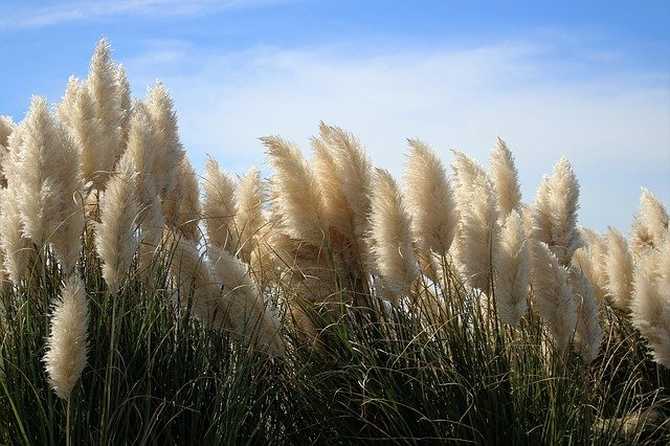
All wild grasses are resilient and not very demanding, as far as care is concerned. Pampas grass is pest-resistant, so you do not have to worry about treating it with pesticides and other chemicals. You do not need to use fertilizer as well except once a year in late winter when you are pruning the grass. All these plants require is a lot of sunlight and warmth. If you prefer low-maintenance garden plants, then consider planting pampas grass on your residential or commercial landscape.
Pruning Pampas Grass
During the spring-time, you can shear the pampas grass foliage to cut it down as desired. It is essential to do this grass pruning every year. Pruning pampas grass removes the grass foliage from the previous year. This allows new leaves and stems to grow and revitalizes the grass. The best time to prune the pampas grass foliage is in late winter. This is right before the next growing season.
To prune pampas grass foliage, you can use long-handled loppers or hedge shears. If you have hedge trimmers, you can also use these. You can cut down the grass foliage very close to the ground level.
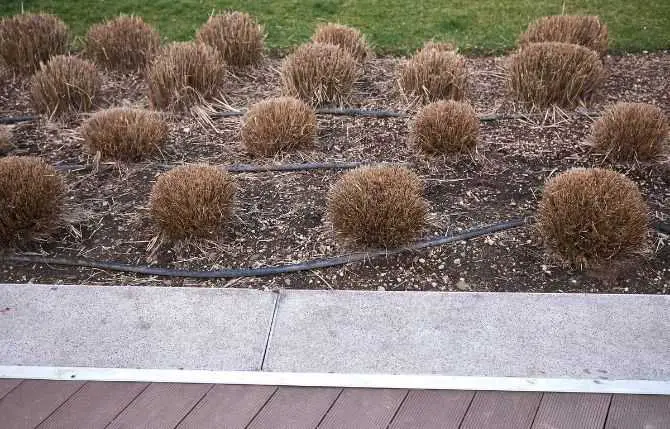
When cutting pampas grass foliage, you must also make sure that there are no kids or pets around because the sharp blades may be harmful to them. It’s also a good idea to wear gloves and a long-sleeved shirt when you are shearing the pampas grass foliage.
There is another alternative to pruning, mainly is the pampas grass is located in areas where you can light a fire and where smoke is not going to affect the nearby people and areas. You can burn the clumps down to the ground in late winter or early spring. This can be a good option because it means that you do not have to worry about using hedge shears.
Once you are done with the pruning process, you can add some fertilizer to the remaining stumps to stimulate foliage growth in the next phase of life. This is an optional step. You can use a complete fertilizer like 8-8-8 or 10-10-10. All you need is a light application on the pampas grass stumps. This can make sure that you are going to grow even more foliage of the decorative shrub in the next year.
Harvesting Pampas Grass Plumes
If you desire to use the pampas grass plumes for indoor decoration and floral arrangements, you need information on when and how to harvest the flowers. You can do this as soon as they fully emerged. You want to beat the shedding period when they are fully matured. There are two options regarding when you can use these plumes. You may want to use them immediately in your arrangements, but you can also wait until these flowers have dried completely. To limit how much shedding occurs, a quick and easy hack is to spray the flowers with some hairspray before using them.
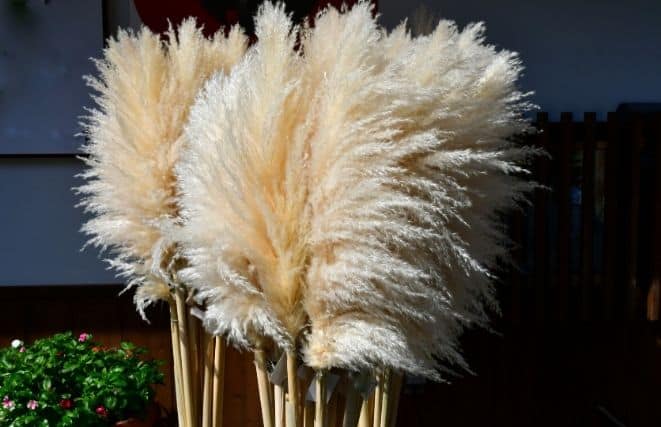
Frequently Asked Questions
There are different varieties of pampas grass. You can choose to grow the more common long varieties or find a dwarf variety. The great thing about dwarf pampas grass is that it still looks great on any landscape, but it does not steal the limelight from other vegetation. It also does not block the view as a taller shrub may do. These dwarf pampas grasses grow to a height of 5 feet.
If you do not want to grow your clumps or are not in a coastal region with the right hardy level for good growth, you can always buy dry pampas flowers for your indoor flower arrangements any time of the year, be it late winter or summer. Many online and offline retailers offer such products.
Pampas grass is known to grow rapidly. This is even the case for varieties that are considered slow-growing. When looking at a pruned pampas grass plant that sits at 6 to 8 inches above the ground, it can effortlessly reach more than 6 feet tall or even more throughout the year. In addition to this, it also tends to spread out and is said to get widths of between 4 and 6 feet across if you don’t make a habit out of regularly thinning or pruning these female plants.
There are various methods that you can use to go about preventing your pampas grass from spreading. However, the most common way of avoiding this spread would be to cut the plant’s flower heads once these have fully emerged, but before the flowers begin setting seeds.
Conclusion
When you grow pampas grass (Cortaderia selloana), you can have a beautiful ornamental shrub to use in any large garden space. It is attractive and also serves a functional purpose as a protective hedge or visual barrier. When you harvest the plumes, you also get a lovely ornamental item for indoor use. You do not need much to grow pampas grass. It requires lots of sunlight but only minimal watering and care. Using fertilizer is also optional. This shrub is very popular, but it is better to grow pampas grass when you can control it well. These grasses are very fast-spreading and invasive, such that they are restricted in a few areas in the USA as well as in other parts of the world.

